Emission Characteristics and Health Risk Assessment of Volatile Organic Compounds in Key Industries: A Case Study in the Central Plains of China
Abstract
1. Introduction
2. Materials and Methods
2.1. Study Sites
2.2. Sample Collection
2.3. VOCs Analysis
2.4. OFP Analysis
2.5. HYSPLIT Model
2.6. Health Risk Analysis
3. Results and Discussion
3.1. Emission Characteristics of VOCs
3.1.1. Concentration Level of VOC Emissions
3.1.2. Composition Characteristics of VOCs
3.1.3. Spatial Distribution of VOCs
3.2. Characteristic Analysis of OFP
3.2.1. Industry Levels of OFP
3.2.2. Composition Characteristics of OFP
3.2.3. Spatial Distribution of TOFP
3.3. HYSPLIT Analysis
3.4. Health Risk Assessment
3.4.1. Carcinogenic Risk Assessment
3.4.2. Non-Carcinogenic Risk Assessment
4. Conclusions
Supplementary Materials
Author Contributions
Funding
Institutional Review Board Statement
Informed Consent Statement
Data Availability Statement
Acknowledgments
Conflicts of Interest
References
- Li, Y.; Yin, S.; Yu, S.; Yuan, M.; Dong, Z.; Zhang, D.; Yang, L.; Zhang, R. Characteristics, source apportionment and health risks of ambient VOCs during high ozone period at an urban site in central plain, China. Chemosphere 2020, 250, 126283. [Google Scholar] [CrossRef] [PubMed]
- Jia, J.; Wang, J.; Jin, W.; Yu, N.; Gong, S.; Ni, J.; Zhang, X.; Zhou, L. Inter-annual variability and health risk assessment of summer VOCs in a Plain City of China. Atmos. Environ. 2024, 337, 120790. [Google Scholar] [CrossRef]
- Wang, R.; Wang, X.; Cheng, S.; Wang, K.; Cheng, L.; Zhu, J.; Zheng, H.; Duan, W. Emission characteristics and reactivity of volatile organic compounds from typical high-energy-consuming industries in North China. Sci. Total Environ. 2022, 809, 151134. [Google Scholar] [CrossRef] [PubMed]
- Yang, Y.; Liu, B.; Hua, J.; Yang, T.; Dai, Q.; Wu, J.; Feng, Y.; Hopke, P.K. Global review of source apportionment of volatile organic compounds based on highly time-resolved data from 2015 to 2021. Environ. Int. 2022, 165, 107330. [Google Scholar] [CrossRef] [PubMed]
- Li, L.; Zhang, D.; Hu, W.; Yang, Y.; Zhang, S.; Yuan, R.; Lv, P.; Zhang, W.; Zhang, Y.; Zhang, Y. Improving VOC control strategies in industrial parks based on emission behavior, environmental effects, and health risks: A case study through atmospheric measurement and emission inventory. Sci. Total Environ. 2023, 865, 161235. [Google Scholar] [CrossRef] [PubMed]
- Zhao, H.; Cheng, Y.; Liu, Y.; Wang, X.; Wang, Y.; Wang, S.; Jin, T. Characteristics of Volatile Organic Compounds Emissions and Odor Impact in the Pharmaceutical Industry. Atmosphere 2024, 15, 1338. [Google Scholar] [CrossRef]
- Wang, H.; Xue, S.; Hao, R.; Fang, L.; Nie, L. Emission Characteristics and Ozone Formation Potential Assessment of VOCs from Typical Metal Packaging Plants. Atmosphere 2021, 13, 57. [Google Scholar] [CrossRef]
- Kim, K.C.; Oh, B.H.; Baek, J.D.; Lee, C.S.; Lim, Y.J.; Joo, H.S.; Han, J.S. Characteristics and Source Profiles of Volatile Organic Compounds (VOCs) by Several Business Types in an Industrial Complex Using a Proton-Transfer-Reaction Time-of-Flight Mass Spectrometry (PTR-ToF-MS). Atmosphere 2024, 15, 1156. [Google Scholar] [CrossRef]
- Li, L.; Wang, F.; Hu, W.; Zhang, D.; Li, Z.; Lv, P.; Xu, Q.; Yuan, R.; Zhang, Y.; Zhang, Y.; et al. Risk-oriented source apportionment and implications for mitigation strategies of VOCs in industrial parks: Insights from odor pollution and health risks. Environ. Int. 2024, 193, 109137. [Google Scholar] [CrossRef] [PubMed]
- Gabriel, M.F.; Felgueiras, F.; Feliciano, M. Children’s Exposure to Volatile Organic Compounds: A Comparative Analysis of Assessments in Households, Schools, and Indoor Swimming Pools. Atmosphere 2024, 15, 1471. [Google Scholar] [CrossRef]
- You, G.; Liu, H.; Sun, R.; Jin, Z.; Li, J.; Zhou, X.; Lu, S.; Xie, S. Characterizing VOCs emissions of five packaging and printing enterprises in China and the emission reduction potential of this industry. J. Clean. Prod. 2023, 420, 138445. [Google Scholar] [CrossRef]
- Hussain, M.S.; Gupta, G.; Mishra, R.; Patel, N.; Gupta, S.; Alzarea, S.I.; Kazmi, I.; Kumbhar, P.; Disouza, J.; Dureja, H.; et al. Unlocking the secrets: Volatile Organic Compounds (VOCs) and their devastating effects on lung cancer. Pathol. Res. Pract. 2024, 255, 155157. [Google Scholar] [CrossRef]
- Lin, Q.; Gao, Z.; Zhu, W.; Chen, J.; An, T. Underestimated contribution of fugitive emission to VOCs in pharmaceutical industry based on pollution characteristics, odorous activity and health risk assessment. J. Environ. Sci. 2023, 126, 722–733. [Google Scholar] [CrossRef]
- Yang, Y.; Ji, D.; Sun, J.; Wang, Y.; Yao, D.; Zhao, S.; Yu, X.; Zeng, L.; Zhang, R.; Zhang, H.; et al. Ambient volatile organic compounds in a suburban site between Beijing and Tianjin: Concentration levels, source apportionment and health risk assessment. Sci. Total Environ. 2019, 695, 133889. [Google Scholar] [CrossRef]
- Guan, Y.; Xiao, Y.; Wang, F.; Qiu, X.; Zhang, N. Health impacts attributable to ambient PM2.5 and ozone pollution in major Chinese cities at seasonal-level. J. Clean. Prod. 2021, 311, 127510. [Google Scholar] [CrossRef]
- Zhang, X.; Xue, Z.; Li, H.; Yan, L.; Yang, Y.; Wang, Y.; Duan, J.; Li, L.; Chai, F.; Cheng, M.; et al. Ambient volatile organic compounds pollution in China. J. Environ. Sci. 2017, 55, 69–75. [Google Scholar] [CrossRef]
- Chen, Y.; Ling, Y.; Liu, F.; Tong, L.; Yang, M.; Shi, Y.; Xue, Y.; Ye, H.; Xu, Y.; Huang, C.; et al. Characteristics and Source Apportionment of Volatile Organic Compounds in a Coastal Industrial Area: A Case Study in the Yangtze River Delta of China. Bull. Environ. Contam. Toxicol. 2024, 113, 16. [Google Scholar] [CrossRef]
- Technical Requirements for Manual Monitoring of Ozone Precursor Organic Compounds in Ambient Air (Environmental Monitoring Guideline 2018 No. 240). 2018. Available online: https://www.mee.gov.cn/gkml/hbb/bgth/201802/t20180228_431887.htm (accessed on 2 February 2018).
- Liu, Y.; Kong, L.; Liu, X.; Zhang, Y.; Li, C.; Zhang, Y.; Zhang, C.; Qu, Y.; An, J.; Ma, D.; et al. Characteristics, secondary transformation, and health risk assessment of ambient volatile organic compounds (VOCs) in urban Beijing, China. Atmos. Pollut. Res. 2021, 12, 33–46. [Google Scholar] [CrossRef]
- Zhang, Y.; Li, C.; Yan, Q.; Han, S.; Zhao, Q.; Yang, L.; Liu, Y.; Zhang, R. Typical industrial sector-based volatile organic compounds source profiles and ozone formation potentials in Zhengzhou, China. Atmos. Pollut. Res. 2020, 11, 841–850. [Google Scholar] [CrossRef]
- Guan, Y.; Liu, X.; Zheng, Z.; Dai, Y.; Du, G.; Han, J.; Hou, L.; Duan, E. Summer O(3) pollution cycle characteristics and VOCs sources in a central city of Beijing-Tianjin-Hebei area, China. Environ. Pollut. 2023, 323, 121293. [Google Scholar] [CrossRef]
- Carter, W.P.L. Development of an Improved Chemical Speciation Database for Processing Emissions of Volatile Organic Compounds for Air Quality Models. 2023. Available online: https://intra.engr.ucr.edu/~carter/emitdb/ (accessed on 9 March 2023).
- Shi, Y.; Huang, C.; Huang, C.; Zhang, H.; Tong, L.; Cai, Q.; He, J.; Xu, H.; Yu, H.; Xiao, H. The impact of emission reduction policies on the results of PM2.5 emission sources during the 2016 G20 summit: Insights from carbon and nitrogen isotopic signatures. Atmos. Pollut Res. 2023, 14, 101784. [Google Scholar] [CrossRef]
- Shi, Y.; Hu, Y.; Jin, Z.; Li, J.; Zhang, J.; Li, F. Nitrate sources and its formation in precipitation during typhoons (In-fa and Chanthu) in multiple cities, East China. Sci. Total Environ. 2022, 838, 155949. [Google Scholar] [CrossRef]
- Li, Q.; Su, G.; Li, C.; Wang, M.; Tan, L.; Gao, L.; Mingge, W.; Wang, Q. Emission profiles, ozone formation potential and health-risk assessment of volatile organic compounds in rubber footwear industries in China. J. Hazard. Mater. 2019, 375, 52–60. [Google Scholar] [CrossRef] [PubMed]
- Wang, H.; Hao, R.; Xie, X.; Li, G.; Wang, X.; Wu, W.; Zhao, H.; Zhang, Z.; Fang, L.; Hao, Z. Emission characteristics, risk assessment and scale effective control of VOCs from automobile repair industry in Beijing. Sci. Total Environ. 2023, 860, 160115. [Google Scholar] [CrossRef]
- Huang, C.; Shi, Y.; Yang, M.; Tong, L.; Dai, X.; Liu, F.; Huang, C.; Zheng, J.; Li, J.; Xiao, H. Spatiotemporal distribution, source apportionment and health risk assessment of atmospheric volatile organic compounds using passive air samplers in a typical coastal area, China. J. Clean. Prod. 2023, 423, 138741. [Google Scholar] [CrossRef]
- Li, R.; Yuan, J.; Li, X.; Zhao, S.; Lu, W.; Wang, H.; Zhao, Y. Health risk assessment of volatile organic compounds (VOCs) emitted from landfill working surface via dispersion simulation enhanced by probability analysis. Environ. Pollut. 2023, 316, 120535. [Google Scholar] [CrossRef]
- Pinthong, N.; Thepanondh, S.; Kondo, A. Source Identification of VOCs and their Environmental Health Risk in a Petrochemical Industrial Area. Aerosol Air Qual. Res. 2022, 22, 210064. [Google Scholar] [CrossRef]
- He, X.; Che, X.; Gao, S.; Chen, X.; Pan, M.; Jiang, M.; Zhang, S.; Jia, H.; Duan, Y. Volatile organic compounds emission inventory of organic chemical raw material industry. Atmos. Pollut. Res. 2022, 13, 101276. [Google Scholar] [CrossRef]
- Liu, Y.; Zeng, C.; Wang, M.; Shao, X.; Yao, Y.; Wang, G.; Li, Y.; Hou, M.; Fan, L.; Ye, D. Characteristics and environmental and health impacts of volatile organic compounds in furniture manufacturing with different coating types in the Pearl River Delta. J. Clean. Prod. 2023, 397, 136599. [Google Scholar] [CrossRef]
- Zhong, Z.; Sha, Q.; Zheng, J.; Yuan, Z.; Gao, Z.; Ou, J.; Zheng, Z.; Li, C.; Huang, Z. Sector-based VOCs emission factors and source profiles for the surface coating industry in the Pearl River Delta region of China. Sci. Total Environ. 2017, 583, 19–28. [Google Scholar] [CrossRef]
- Cheng, N.; Jing, D.; Zhang, C.; Chen, Z.; Li, W.; Li, S.; Wang, Q. Process-based VOCs source profiles and contributions to ozone formation and carcinogenic risk in a typical chemical synthesis pharmaceutical industry in China. Sci. Total Environ. 2021, 752, 141899. [Google Scholar] [CrossRef]
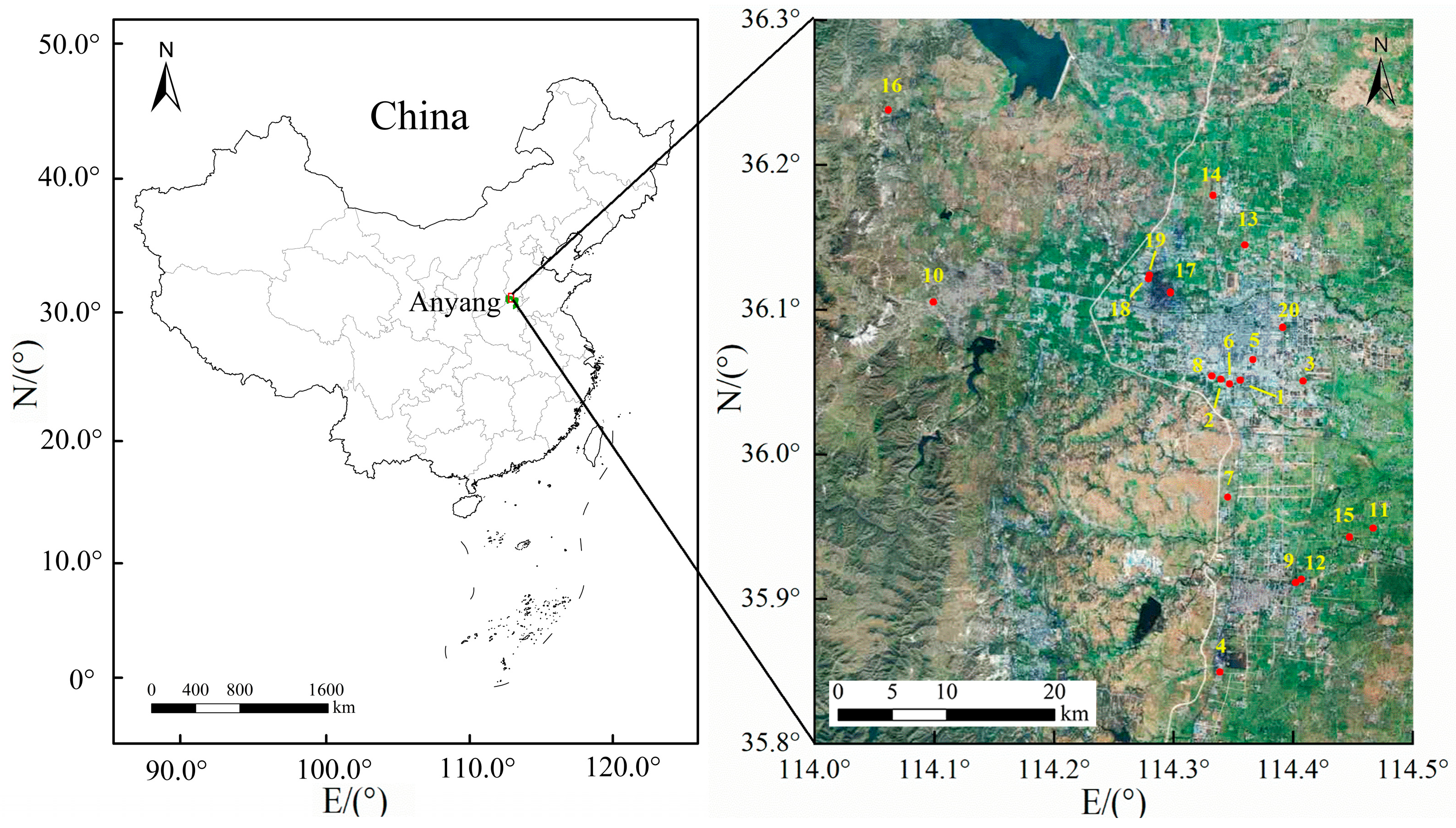
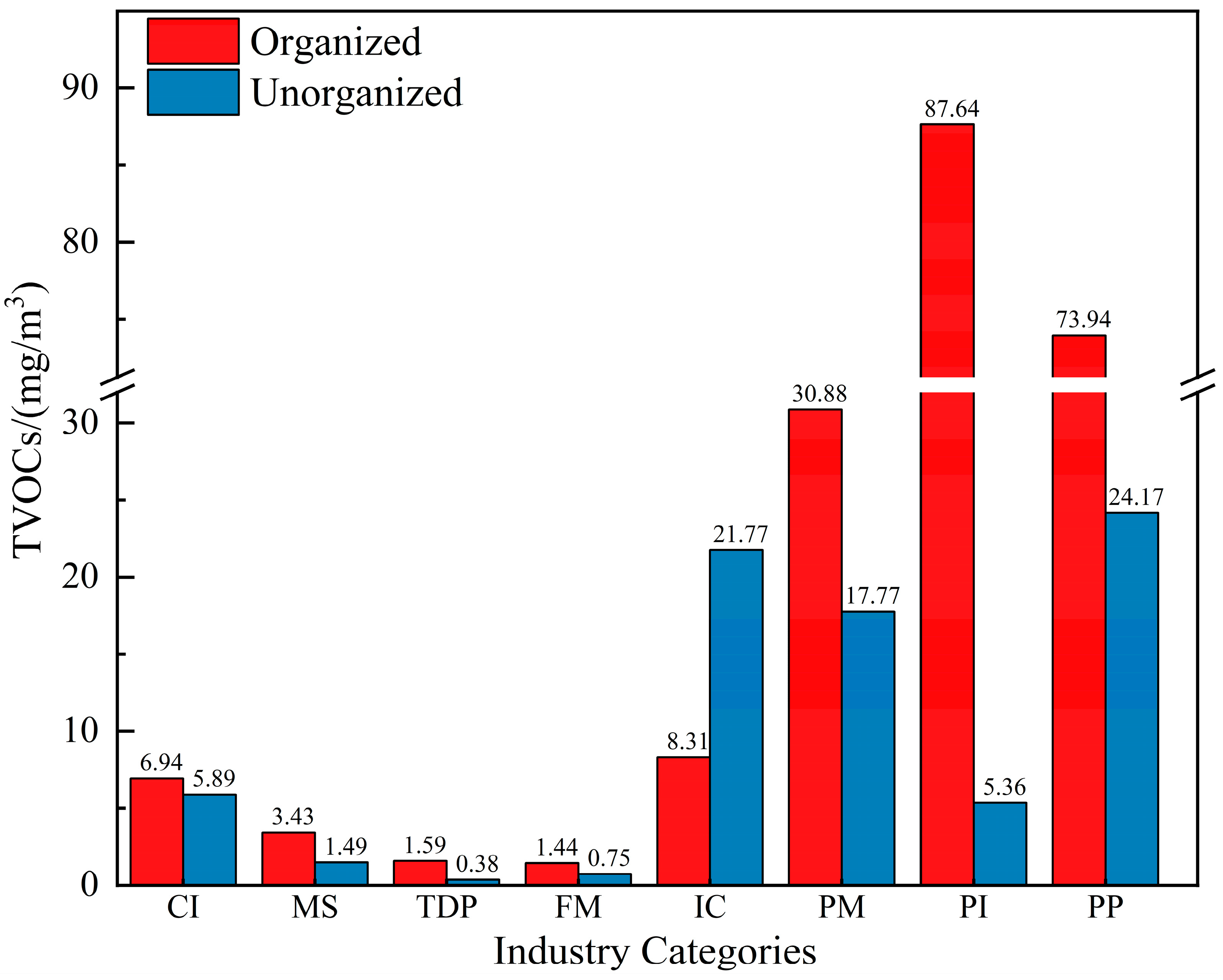
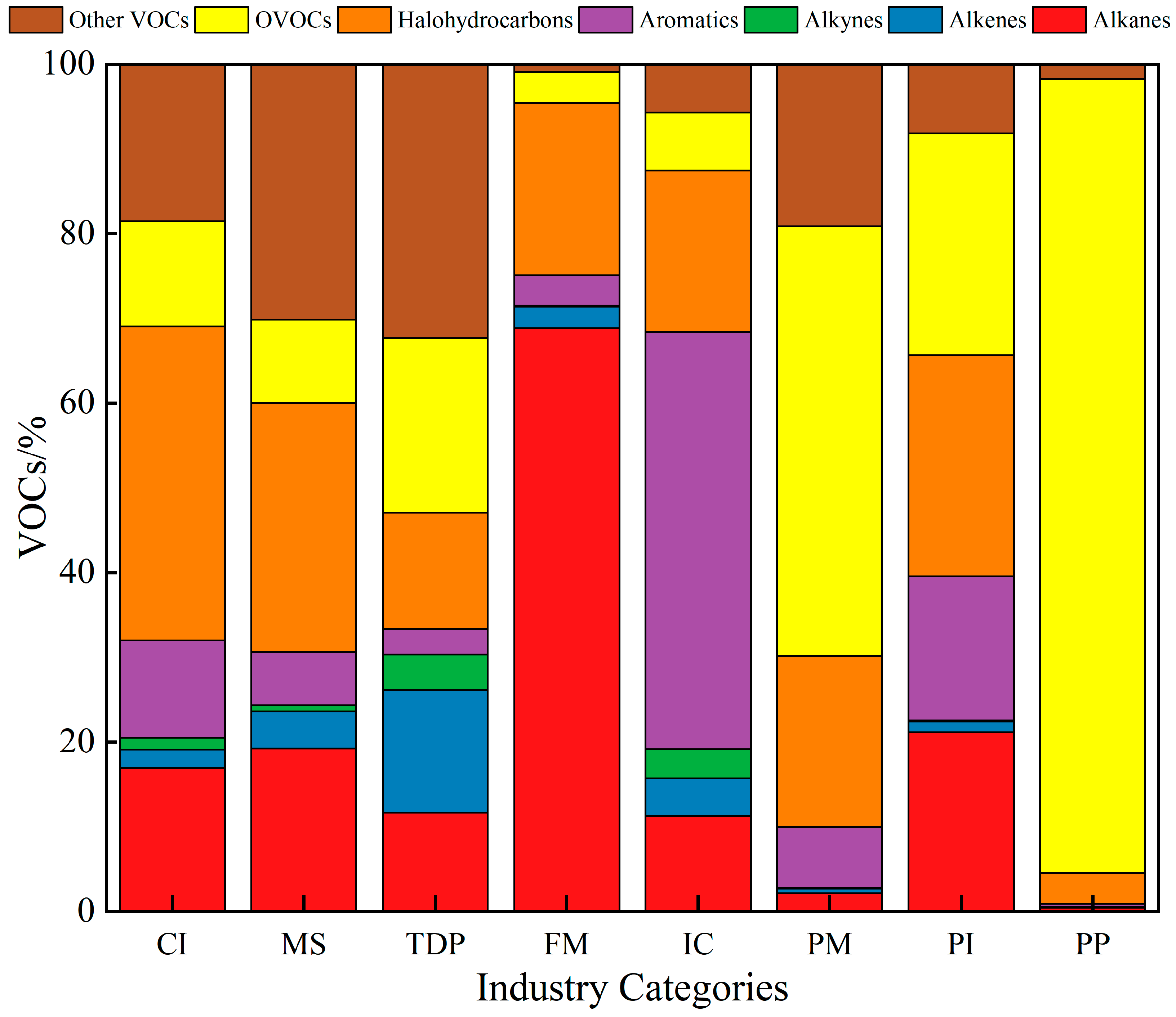
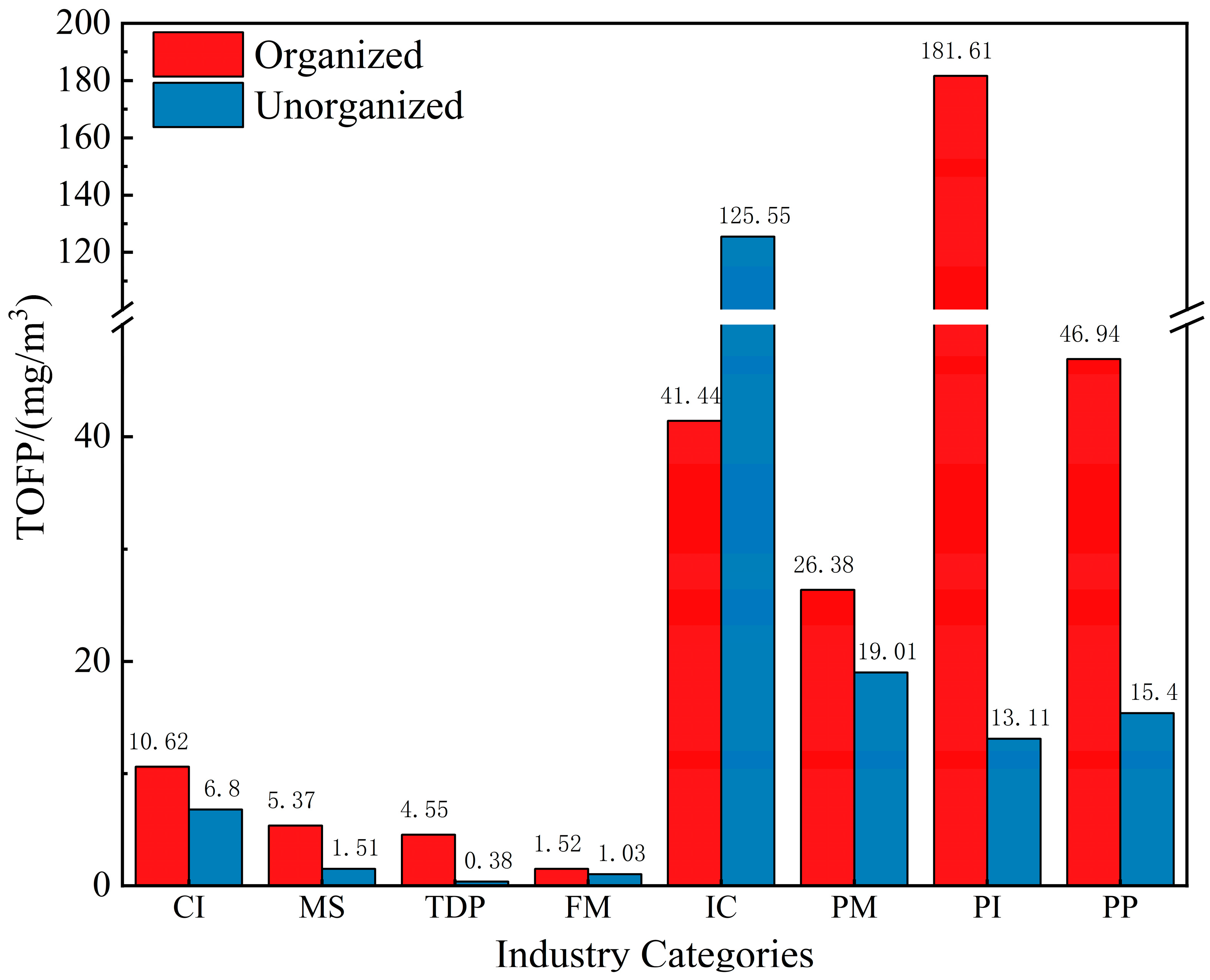
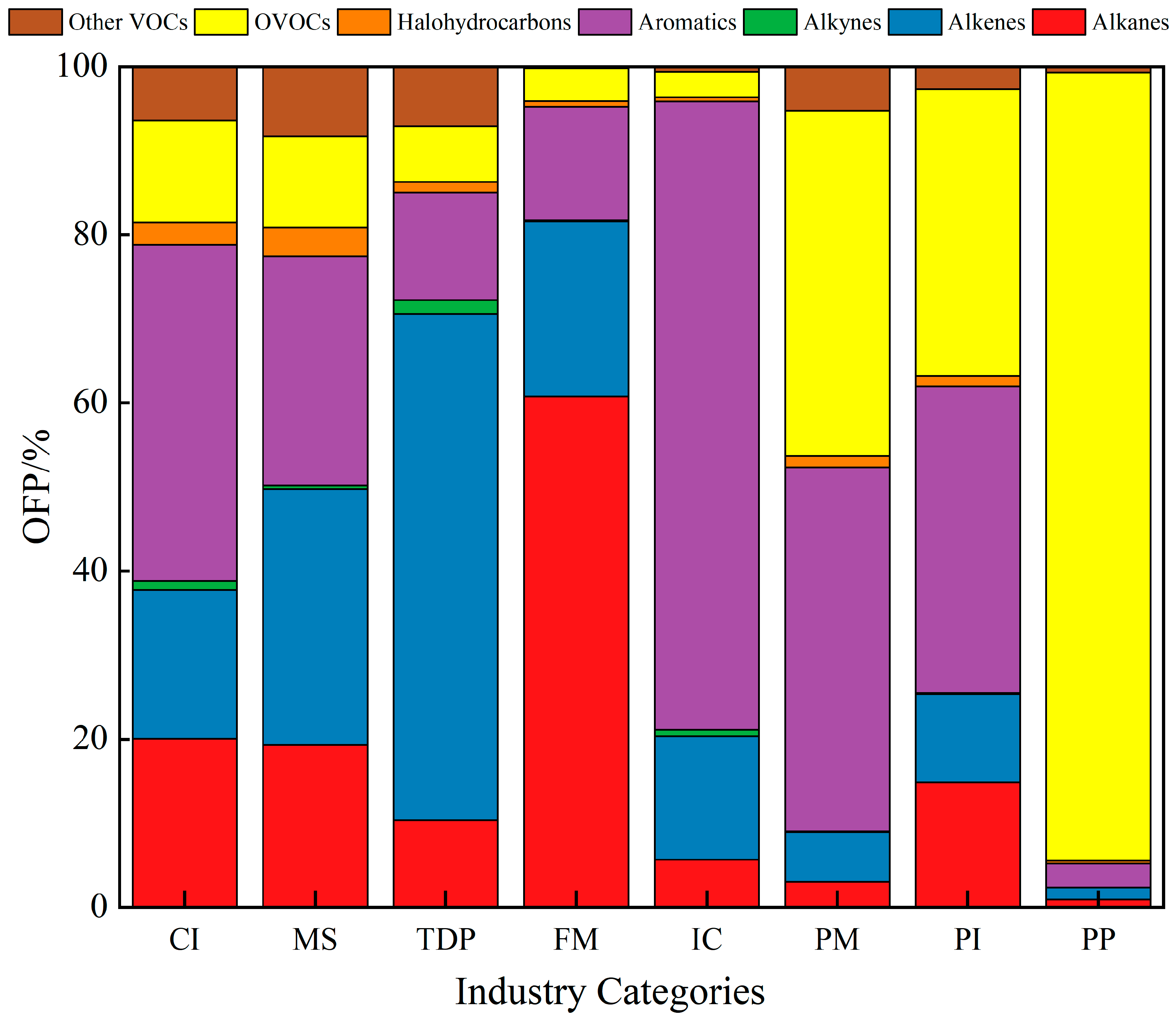
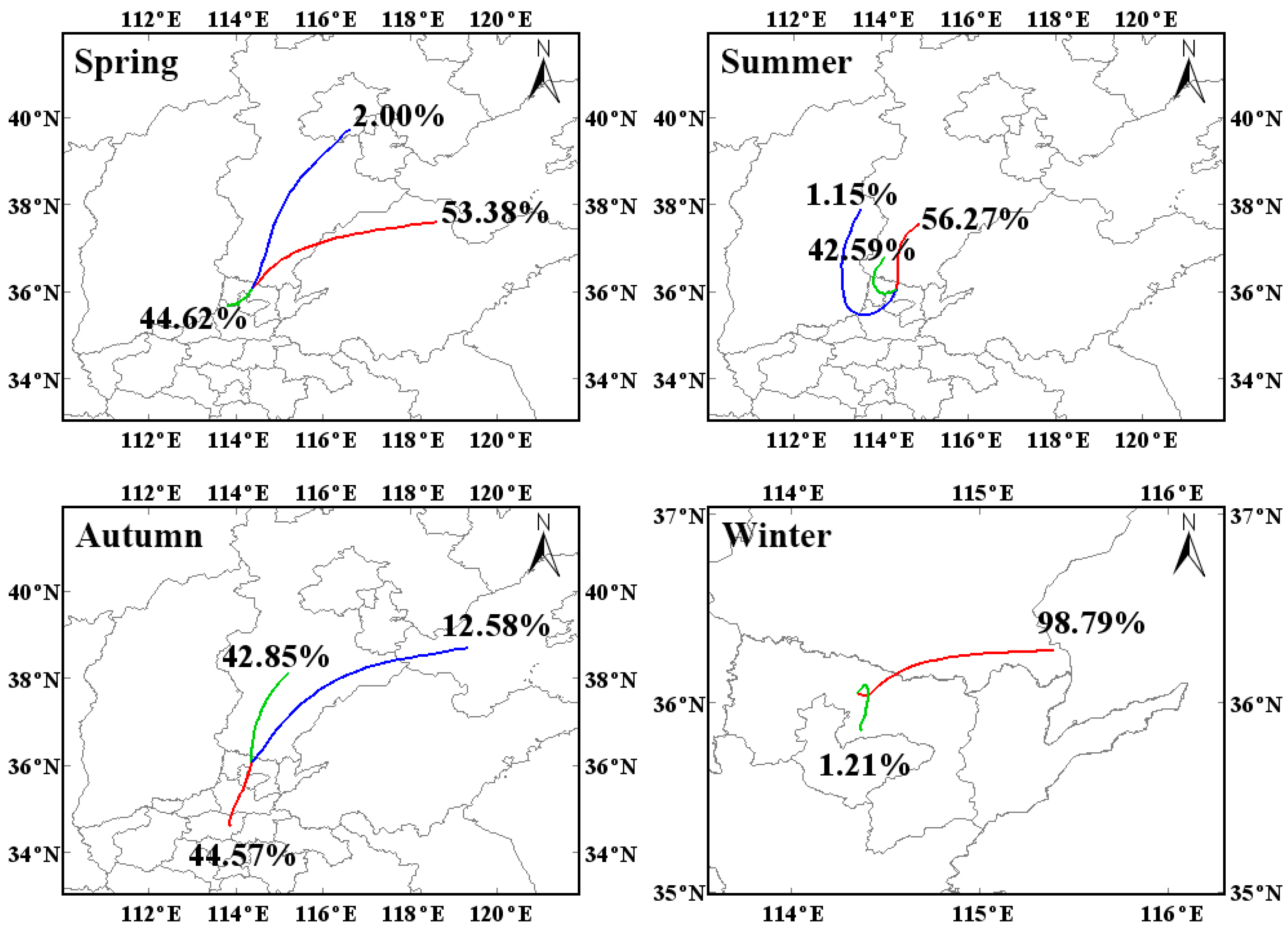
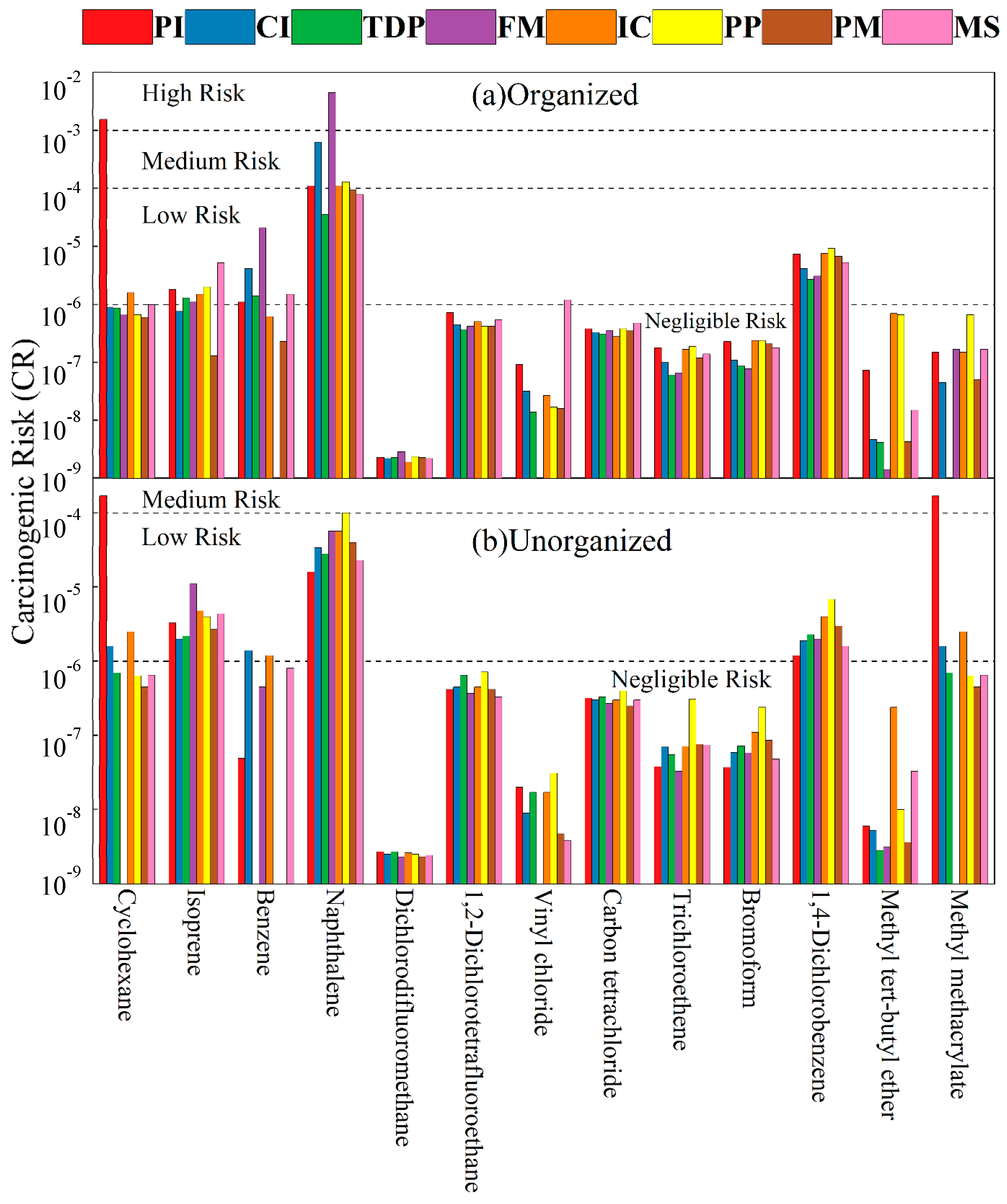

| Industry Categories | ∑CR in Organized Emissions | ∑CR in Unorganized Emissions |
|---|---|---|
| Pharmaceutical industry | 1.66 × 10−3 | 3.61 × 10−4 |
| Chemical industry | 6.41 × 10−4 | 4.34 × 10−5 |
| Textile printing and dyeing | 4.31 × 10−5 | 3.50 × 10−5 |
| Furniture manufacturing | 4.55 × 10−3 | 7.12 × 10−5 |
| Industrial coating | 1.23 × 10−4 | 7.32 × 10−5 |
| Packaging and printing | 1.45 × 10−4 | 1.14 × 10−4 |
| Paint manufacturing | 1.02 × 10−4 | 4.74 × 10−5 |
| Metal smelting | 9.37 × 10−5 | 3.19 × 10−5 |
Disclaimer/Publisher’s Note: The statements, opinions and data contained in all publications are solely those of the individual author(s) and contributor(s) and not of MDPI and/or the editor(s). MDPI and/or the editor(s) disclaim responsibility for any injury to people or property resulting from any ideas, methods, instructions or products referred to in the content. |
© 2025 by the authors. Licensee MDPI, Basel, Switzerland. This article is an open access article distributed under the terms and conditions of the Creative Commons Attribution (CC BY) license (https://creativecommons.org/licenses/by/4.0/).
Share and Cite
Liu, F.; Tong, L.; Luo, Q.; Ling, Y.; Gu, H.; Lv, Y.; Shi, A.; Liu, H.; Xiao, H.; Huang, C. Emission Characteristics and Health Risk Assessment of Volatile Organic Compounds in Key Industries: A Case Study in the Central Plains of China. Atmosphere 2025, 16, 74. https://doi.org/10.3390/atmos16010074
Liu F, Tong L, Luo Q, Ling Y, Gu H, Lv Y, Shi A, Liu H, Xiao H, Huang C. Emission Characteristics and Health Risk Assessment of Volatile Organic Compounds in Key Industries: A Case Study in the Central Plains of China. Atmosphere. 2025; 16(1):74. https://doi.org/10.3390/atmos16010074
Chicago/Turabian StyleLiu, Fengwei, Lei Tong, Qingyue Luo, Yufei Ling, Hongyi Gu, Yangchao Lv, Anwei Shi, Hui Liu, Hang Xiao, and Cenyan Huang. 2025. "Emission Characteristics and Health Risk Assessment of Volatile Organic Compounds in Key Industries: A Case Study in the Central Plains of China" Atmosphere 16, no. 1: 74. https://doi.org/10.3390/atmos16010074
APA StyleLiu, F., Tong, L., Luo, Q., Ling, Y., Gu, H., Lv, Y., Shi, A., Liu, H., Xiao, H., & Huang, C. (2025). Emission Characteristics and Health Risk Assessment of Volatile Organic Compounds in Key Industries: A Case Study in the Central Plains of China. Atmosphere, 16(1), 74. https://doi.org/10.3390/atmos16010074






